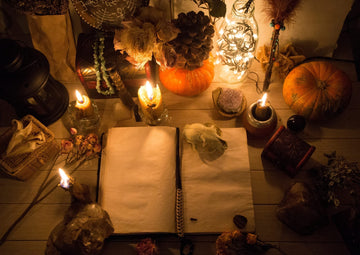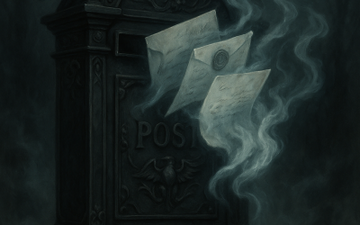Whispers on Paper: Haunted Letters, Witch Trials, and the Occult Secrets of Spells and Grimoires
by Gretchen Upshaw on Jul 19, 2025

Historians have used letters for centuries to decipher the climate of eras and the thoughts of those who lived in them. From the echoing halls of medieval monasteries to the voiceless accused of witch-trial courts, letters and manuscripts have always held power far beyond mere ink and paper. In the world of witchcraft and the occult, the written word is more than communication—it’s esoteric spellcraft, dark secrecy, and sometimes a cruel weapon.
Letters in the Dark’s first subscription series, The Initiation: 12 Haunted Nights, was influenced by the haunting legacy of letters in the history of witchcraft, witch trials, and the hidden world of grimoires. Long before modern mailboxes and, obviously, email, haunted letters, spooky letters, and snail mail dripping with occult secrets were the lifeblood of magic, fear, and forbidden knowledge.

The Written Word: A Tool of Witchcraft and Fear
For centuries, people believed that words possessed mystical power. Spells spoken aloud could bend fate, but words written and preserved on parchment were even stronger. Written charms could protect crops, heal the sick, or serve darker purposes by cursing an enemy into ruin.
This belief gave rise to countless grimoires: handwritten books filled with spells, rituals, symbols, and astrological tables. But the pages of these sacred books of wisdom were to stay bound. So, practitioners and accusers relied on letters sent to express their discoveries and fears. These haunted letters encouraged collaborations between mystics and magick workers, as well as sparked witch hunts that brought terror to villages, towns, and entire countries.
The written word was a double-edged sword: it could protect the faithful or destroy the accused.
Witch Trials and the Letters That Fueled Them
No chapter in witchcraft history reveals the power of letters more chillingly than the witch trials that swept Europe and colonial America from the 15th to the 18th centuries.
While we often picture fiery sermons or courtroom accusations, historians know that behind the scenes, a web of private letters, official correspondences, and frantic petitions fueled the flames of hysteria.
Letters as Accusations
Many don’t realize that letters were the spark that ignited the witch trials:
- Neighbors wrote secret letters to magistrates, accusing women of consorting with the Devil.
- Parishioners sent reports to bishops about suspicious healers or midwives.
- Anonymous letters described dark rituals and nefarious gatherings witnessed under the light of the moon.
These letters became evidence, their words twisted into proof of witchcraft. The mere act of receiving a letter about witchcraft could doom an individual, usually a woman, to torture and execution.
 The Salem Witch Trials: The Haunting Letters in New England
The Salem Witch Trials: The Haunting Letters in New England
Nowhere is the power of letters more vividly documented than in the Salem witch trials of 1692.
Historians have uncovered dozens of letters written during the panic, including:
- Clergy debated whether spectral evidence (ghosts appearing in dreams) should be allowed in court.
- Wealthy families were writing to distant relatives, begging for legal help.
- Letters from Thomas Brattle, a member of the Royal Society, condemned the trials as a dangerous delusion.
These letters are the heart of Salem’s true story. They reveal fear, politics, and desperate attempts to halt the madness. Without these surviving documents, we’d know only the official court records, which in some cases appear to be even more biased than some of the accusatory letters.
Letters from the Accused
Among the most poignant artifacts in the history of witchcraft are letters written by the accused themselves.
The cackles of pure emotion resonated on their pages:
- Pleas for mercy.
- Proclamations of innocence.
- Prayers scribbled in trembling hands.
One chilling example comes from Katharina Kepler, the mother of astronomer Johannes Kepler. Accused of witchcraft in 1615 in Württemberg, Germany, she was imprisoned for 14 months. Letters written by her son defending her innocence were crucial in securing her release and escape from the stake.
Each letter feels like a fragile thread, spun between the living and the doomed—a whisper from the dark.
Letters as Protection: The Himmelsbrief
Not all letters in witchcraft history carried threats. Some were believed to offer divine protection.
In medieval and early modern Europe, people circulated the Himmelsbrief, also known as the “Heaven’s Letter.” These mysterious letters, purported to be written by Christ, angels, or saints, promised blessings to those who copied and distributed them. (Were these the first “Chain Letters?”)
Yet even these “holy letters” had a sinister edge:
“He who does not copy this letter will fall into misfortune.”
In other words, the Himmelsbrief was the original “scare mail.” A haunting blend of faith and fear, these letters were hung in homes, tucked into clothing, and carried as talismans against witches and demons.
Grimoires: Letters to the Unknown
Beyond personal letters, grimoires remain the most mysterious and misunderstood written artifacts in the history of witchcraft.
A grimoire isn’t merely a spellbook—it’s a letter to “Spirit.” It’s written correspondence between a human practitioner and the unseen forces of the universe.
- Medieval grimoires contained elaborate instructions for summoning angels, demons, or spirits.
- Many included rituals requiring written sigils or charms to be burned, buried, or sewn into clothing.
- Some were written in codes or invented languages to hide their secrets.
For centuries, merely owning a grimoire could be enough to brand someone a witch. Church and state authorities hunted down these books, burning them alongside those accused of practicing the forbidden arts.
Grimoires and Mystery Schools

Throughout Europe, certain occult scholars formed Mystery Schools—secret societies dedicated to preserving magical knowledge. Members exchanged letters filled with:
- Secret symbols.
- Alchemical formulas.
- Philosophical debates about magic’s moral purpose.
Such letters often read like a hybrid between scientific papers and magical treatises, hinting at vast cosmic secrets waiting to be unlocked.
This atmosphere of hidden learning is precisely what shapes the fictional Eastern Star School of Magick & Mysticism in Letters in the Dark. It’s a modern echo of the same esoteric scholarship that once filled Europe’s libraries with forbidden manuscripts.
Haunted Letters and Spooky Letters in Pop Culture
The notion of haunted letters and spooky letters endures far beyond historical witch trials. Modern culture continues to obsess over sinister mail:
- Horror films like The Ring revolve around cursed messages that doom the recipient unless passed on—echoing the logic of chain letters.
- True-crime tales feature killers like the Zodiac or BTK who sent taunting letters to police and newspapers.
- Internet “creepypasta” stories modernize the tradition of scare mail, warning readers to share—or suffer supernatural consequences.
These modern legends keep the concept of haunted correspondence alive, proving that even in the digital age, snail mail can still send chills down your spine.
Letters in the Dark: Carrying On a Haunting Tradition
At Letters in the Dark, we’re deeply inspired by this rich history of written magic, mystery, and fear. Our haunted letter subscription is more than entertainment, it’s an homage to centuries of:
- Secret letters exchanged in the dead of night.
- Grimoires hidden under floorboards.
- Trials where a single piece of paper could mean salvation—or death.
With each handcrafted letter, we revive the gothic tradition of spooky letters—but with a modern, immersive twist.
Imagine receiving:
- A parchment letter penned by a supernatural explorer.
- The scent of mysterious herbs emanating from the envelope.
- Wax seals evoking medieval seals of power.
- Artifacts tucked inside—like a page torn from a grimoire or a spelled charm once used in an ancient ritual.
Each piece of scare mail is designed to stir your senses, spark curiosity, and draw you deeper into the shadows.
The Initiation: A Modern Witch’s Tale

In our current story arc, The Initiation: 12 Haunted Nights, protagonist Gitta Nettle faces trials reminiscent of historic witchcraft initiations. As a brilliant student of the Eastern Star School of Magick & Mysticism, she must project herself into haunted locations and solve supernatural mysteries.
Gitta’s world is a seamless blend of:
- Witchcraft history.
- Academic occult study.
- The deeply personal, chilling power of letters.
Through her eyes, subscribers witness how letters can still serve as keys to hidden realms, just as they did for witches, mystics, and scholars throughout the ages.
Why Haunted Letters Still Fascinate Us
There’s a reason haunted letters captivate us:
* They feel deeply personal—a whisper meant only for us.
* They connect us to history, echoing secrets passed down for centuries.
* They feed our primal curiosity about what lies beyond the veil.
Whether they come from an ancient grimoire, the quill of a terrified witch, or the gothic parchment of Letters in the Dark, spooky letters remain timeless conduits of magic and fear.
Dare to Open Your Haunted Letters?
The story continues with Letters in the Dark. Through handcrafted haunted letters, we invite you to step into a world where:
- Witch trials and grimoires hold deadly secrets.
- Letters arrive smelling of ancient herbs and dripping with occult wisdom.
- Every envelope is a doorway into the unknown.
Join Gitta on her initiation. Let the echoes of history guide you. And remember: sometimes the most powerful magic still comes…
In the mail.


